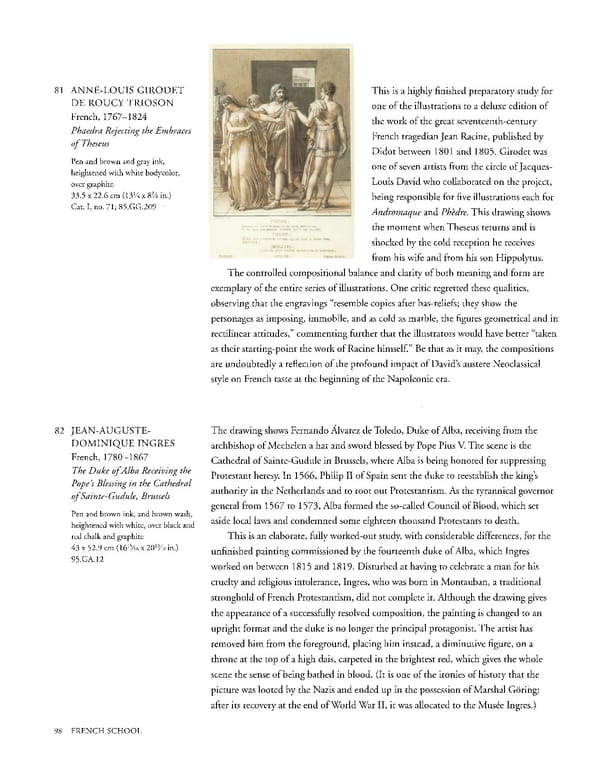81 ANNE-LOUIS GIRODET This is a highly finished preparatory study for DE ROUCY TRIOSON one of the illustrations to a deluxe edition of French, 1767-1824 the work of the great seventeenth-century Phaedra Rejecting the Embraces French tragedian Jean Racine, published by of Theseus Didot between 1801 and 1805. Girodetwas Pen and brown and gray ink, one of seven artists from the circle of Jacques- heightened with white bodycolor, over graphite Louis David who collaborated on the project, 33.5 x 22.6 cm (13¼ x 8 in.) being responsible for five illustrations each for Cat. I, no. 71; 85.GG.209 Andromaque and Phedre. This drawing shows the moment when Theseus returns and is shocked by the cold reception he receives from his wife and from his son Hippolytus. The controlled compositional balance and clarity of both meaning and form are exemplary of the entire series of illustrations. One critic regretted these qualities, observing that the engravings "resemble copies after bas-reliefs; they show the personages as imposing, immobile, and as cold as marble, the figures geometrical and in rectilinear attitudes," commenting further that the illustrators would have better "taken as their starting-point the work of Racine himself." Be that as it may, the compositions are undoubtedly a reflection of the profound impact of David's austere Neoclassical style on French taste at the beginning of the Napoleonic era. 82 JEAN-AUGUSTE- The drawing shows Fernando Alvarez de Toledo, Duke of Alba, receiving from the DOMINIQUE INGRES archbishop of Mechelen a hat and sword blessed by Pope Pius V. The scene is the French, 1780-1867 Cathedral of Sainte-Gudule in Brussels, where Alba is being honored for suppressing The Duke of Alba Receiving the Protestant heresy. In 1566, Philip II of Spain sent the duke to reestablish the king's Pope's Blessing in the Cathedral of Sainte-Gudule, Brussels authority in the Netherlands and to root out Protestantism. As the tyrannical governor general from 1567 to 1573, Alba formed the so-called Council of Blood, which set Pen and brown ink, and brown wash, heightened with white, over black and aside local laws and condemned some eighteen thousand Protestants to death. red chalk and graphite This is an elaborate, fully worked-out study, with considerable differences, for the 43 x 52.9 cm (16 15/16 x 20 13/16 in.) unfinished painting commissioned by the fourteenth duke of Alba, which Ingres 95.GA.12 worked on between 1815 and 1819. Disturbed at having to celebrate a man for his cruelty and religious intolerance, Ingres, who was born in Montauban, a traditional stronghold of French Protestantism, did not complete it. Although the drawing gives the appearance of a successfully resolved composition, the painting is changed to an upright format and the duke is no longer the principal protagonist. The artist has removed him from the foreground, placing him instead, a diminutive figure, on a throne at the top of a high dais, carpeted in the brightest red, which gives the whole scene the sense of being bathed in blood. (It is one of the ironies of history that the picture was looted by the Nazis and ended up in the possession of Marshal Goring; after its recovery at the end of World War II, it was allocated to the Musee Ingres.) 98 FRENCH SCHOOL
 Masterpieces of the Getty Museum: Drawings Page 98 Page 100
Masterpieces of the Getty Museum: Drawings Page 98 Page 100